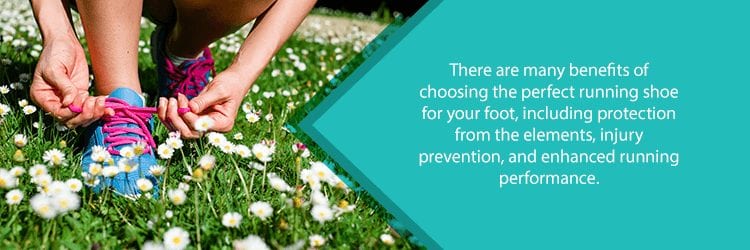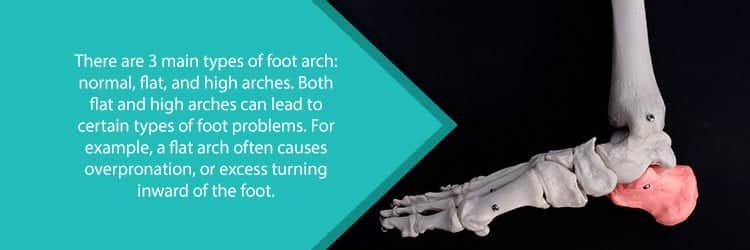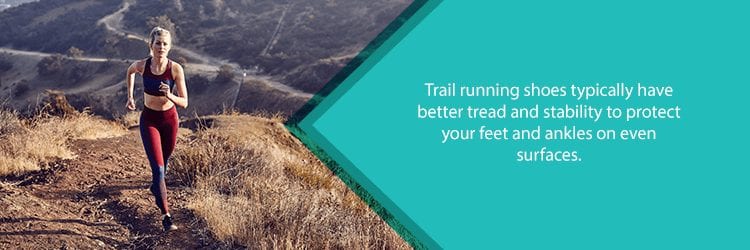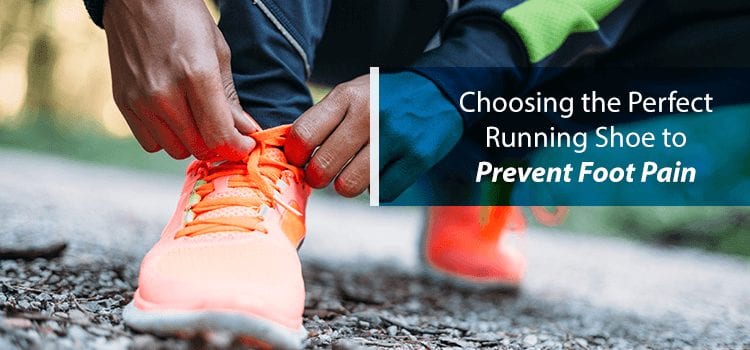As the spring air refreshes our lungs and warms our faces, the urge to lace up that old pair of running shoes beckons. After all, running is a great cardiovascular exercise. It clears the mind, relieves stress, and helps you see little sections of the world you wouldn’t even notice in a car.
Before you head out on a long, cathartic run, you may want to consider getting a new pair of running shoes. Most running shoes are only designed to last about 500 miles. How many miles have you already put on yours?
However, there are some important facets you may want to consider when hunting for the perfect running shoe. By understanding your foot structure and running style, you can choose a pair with the exact features you need to increase performance and prevent injury.

The Benefits of Good Running Shoes
Like many things in life, running shoes fall into the category of you get what you pay for. While you may be tempted to search for a bargain, running shoes should be considered an investment. Good running shoes offer several benefits including:
- Protection: Your shoes separate your feet from the road, sidewalk, or trail. As any runner knows, there are all sorts of hazards on your route. Jagged rocks, broken glass, even the occasional “surprise” left behind by an animal. Running shoes are your line of defense from cuts, bruises, and incredibly dirty socks.
- Preventing injuries: All the health benefits of running won’t mean a thing if you’re injured. Running on hard surfaces like asphalt or concrete can be stressful to your feet, legs, and hips. High-quality running shoes give you support and shock absorption that can prevent conditions like shin splints or plantar fasciitis.
- Increasing running performance: The right shoes will give you the proper support and improve your biomechanics. As a result, you may be able to run faster or longer.
Finding the Perfect Running Shoe
Before you head out to your favorite retailer, you probably want to learn more about your foot and how you run.
How Do You Run?
Take some time to examine your old pair of running shoes. The wear and tear patterns on the soles can help you determine your running mechanics.
What can the soles of your shoes tell you? The natural tendencies of your movements while running—also known as your gait. More specifically, the degree of pronation—the roll of your foot as the heel strikes the ground.
- Neutral pronation: If the wear pattern of your shoes is at the center of the ball of your foot and a small outer section of the heel, then congratulations! You have what’s considered neutral pronation. This running style efficiently absorbs impact and helps to relieve pressure on the knees and joints.
- Overpronation: If the wear patterns are near the inside, along the balls of the feet and heels you may have a tendency to roll your foot inward while running. This is a common movement many runners unknowingly make. Unfortunately, overpronation puts runners at risk for knee injuries.
- Supination: Wear patterns at the outer edge of the shoe indicate an outward rolling of the feet while running. Supination is less common in runners.

Determining Your Foot Arch
According to the Mayo Clinic, you can get a pretty good idea of your foot arch by dipping your feet in water and stepping on a piece of cardboard. The print that remains is a simple way to determine your arch.
There are three main types of foot arches:
- Normal arch: Sometimes referred to as a medium arch, this is the sign of a biomechanically efficient foot. How can you tell? The middle part of your footprint is about half-filled
- Flat arch: If your footprint appears to be a complete foot, you probably have flat feet. Overpronation is more common for those with a flat arch. This can cause muscle stress and joint problems without proper motion control and stability.
- High arch: An incomplete middle part of your footprint can indicate a high arch. Your feet may not efficiently absorb shock while running. This can put excessive strain on your muscles and joints. Arch support insoles and cushioning may help counteract a high arch.
If you are not comfortable with the results from a piece of cardboard, a podiatrist can also examine the arch of your feet and assess pronation.
Types of Running Shoes
So what is the perfect running shoe for you? There are a few factors to consider. First, you want to identify the type of shoe based on your running habits. For example, if you love running scenic forest trails, you will choose a different shoe than someone who runs in an urban environment.
Types of running shoes include:
- Road running shoes: Designed for runners spending most of their time on concrete or asphalt surfaces. The cushioning of these shoes helps with stability and shock absorption while logging in miles on hard, even surfaces.
- Motion control shoes: If you noticed a tendency for overpronation, motion control shoes can help with your gait. These shoes have stiffer heels and aid with your running mechanics.
- Minimalist shoes: These lightweight shoes have less protection and cushion than ordinary running shoes. They also have a zero heel-to-toe drop (discussed later) to encourage you to land on the middle or front of your foot while running.
- Trail running shoes: If you love cross country running or hitting the trails, these shoes have better tread and stability to protect you on uneven surfaces.

The Anatomy of Running Shoes
Running shoes have three main parts—uppers, midsoles, and outsoles. Each part offers features that can increase your comfort, performance, and stability. Let’s take a look at each part of the shoe.
Uppers
These are the tops of your shoes. Many running shoes have a synthetic leather or nylon mesh. This makes the shoes breathable. What exactly does that mean? Breathable shoes use materials that encourages airflow while pushing body heat out. This keeps your feet and socks from becoming a sweaty, overheated mess.
Some running shoes also have waterproof upper membranes to keep the moisture out. This is a great feature when running in the rain or through the inevitable puddle on a trail or sidewalk.
Midsoles
The midsoles are the middle of your shoe. Most running shoes use ethyl vinyl acetate (EVA), which offers the majority of the cushioning. Some shoe brands also use gels or encapsulated air.
In addition, motion control shoes have a medial post. This is usually a denser area of EVA to provide more stability and help control excessive pronation.
Outsoles
The outsoles are the bottom of your running shoe. In many cases, the heel area is made with a protective carbon rubber. The front of the outsoles may be made with blown rubber, which helps with cushioning.
Outsoles have different features based on your running style. They include:
- Heel-to-toe drop: The difference of height between the heel and the toe. The heel-to-toe drop affects how your foot strikes the ground. Lower drops promote a midfoot or forefoot strike. High drops encourage heel striking.
- Heel counter: The structure around the heel providing motion control and cushioning. A heel counter can help those who have recurring issues like Achilles tendonitis.
Which Running Shoes is Best for You?
As you can see, there is a lot to consider when purchasing a new pair of running shoes. Know your feet, how you run, and in what settings you log the most miles. These factors are the best stepping stones on your journey to finding the perfect running shoe.
Here are a few more tips:
- Try to shoe shop in the evening. As the day wears on, your feet tend to swell. Trying on shoes first thing in the morning may prove to be a tight fit for your invigorating evening run.
- Get the right fit. Your shoe width should be snug but not tight. Give your toes, however, a little extra space.
- Understand your actual shoe size may vary by model or manufacturer. Trying the shoes on and moving around with them will help determine a good fit.
- Don’t hesitate to ask for help. Your podiatrist can give you valuable insights about choosing the perfect running shoe. This is especially true if you had previous injuries.
Need some help finding that perfect running shoe because of orthopedic issues? Consider scheduling a consultation with the dedicated team at NJ Spine & Orthopedic. Call us today at (855) 586-2615. We would love to find you a shoe you can enjoy throughout the running season.

